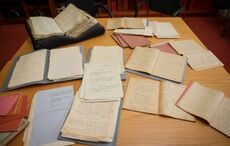In 1930, a visitor to Ireland wrote to a friend:
“You must see Killarney…Can you imagine mountains of rhododendrons rising and massive into the bluest sky you’ve ever been under – white, crimson, scarlet, pink, buff, yellow and every shade God has painted on leaf and flower? As if this was not beauty enough, you come out of a mountain pass and gaze, breathless and trembling upon ‘purple peaks that out of ancient woods arise,’ and there in the gorge below, are silver lakes, reflecting as in a row of mirrors all the glory that surrounds them!”
Such a vivid description suggests an eye for art and an ear for poetry. So it may be surprising to learn that the author of this ode to Irish beauty was none other than Helen Keller, who lived her famous life both deaf and blind.
Keller visited Ireland along with her “miracle worker” teacher Annie Sullivan, whose parents were born in Limerick.
This trip, however, was no joyous homecoming for Sullivan. She did not share her pupil’s enthusiasm for Ireland. In fact, Sullivan was reluctant to make the trip, in part because it forced her to confront her far-from-idyllic Irish immigrant childhood. One biographer even suggests that Ireland forever haunted Annie Sullivan.
Thus, if Annie Sullivan’s triumph with Helen Keller represents the bright side of the Irish-American experience – the faith in hard work, education and advancement – there is also a much darker side.
Back on Broadway
The story of Helen Keller and Annie Sullivan is, by now, world famous. This March, yet another generation of theatergoers will flock to see a new Broadway production of The Miracle Worker, the William Gibson play that was adapted into an award-winning film in 1962, starring Anne Bancroft and Patty Duke.
This time around, on Broadway, Alison Pill (last seen in Martin McDonough’s Irish play The Lieutenant of Inishmore) will star as Annie Sullivan while 13-year-old Irish-American Hollywood starlet Abigail Breslin will portray Keller.
Though at times harrowing, The Miracle Worker is generally seen as an inspiring story, in which a teacher and pupil overcome great obstacles so that they can communicate with each other and then go out into the world and help others do the same.
But there is another side to the Annie Sullivan and Helen Keller saga, a side in which the Irish immigrant experience is central.
What happened to Annie Sullivan’s Irish immigrant parents? How did young Annie Sullivan emerge from this dark Irish odyssey to become one of the world’s most famous and inspirational women? What ultimately did Annie feel about Ireland and her Irish roots, and what role did they play when it came to her famous breakthrough with Helen Keller? Finally, how does Ireland today remember Annie Sullivan?
North and South
One year after the end of the American Civil War, in 1866, Annie Sullivan was born in Feeding Hills, Massachusetts. A recent biography of Sullivan, Beyond the Miracle Worker by Kim E. Nielsen, notes that “the first years of [Sullivan’s] life are largely undocumented and remain obscure.”
What we do know is that young Annie endured grim conditions which, sadly, were familiar to the children of the Irish immigrants flocking to the northeastern United States in the years after the Great Famine struck Ireland.
Annie was the oldest of five children, born to parents who had left Limerick at the height of the Great Hunger. Thomas and Alice Sullivan baptized their children in a heavily Irish Massachusetts parish, but the traumas of their journey from Ireland followed them to America. Thomas Sullivan was a farmhand but he was also an alcoholic who eventually abandoned the family. Worse still, Alice died when Annie was just eight.
In the 1962 film version of The Miracle Worker, Annie looks back on her youth with almost gothic horror, as she and her brother are separated from their parents and sent to an orphanage.
Helen Keller, meanwhile, was born in southern United States in 1880, to a family with strong ties to the former Confederacy. Keller’s mother was a cousin of General Robert E. Lee, while her father was a Confederate officer. Keller was not born deaf and blind. When she was nineteen months old, she became severely ill with what was most likely meningitis or scarlet fever. Keller not only lost her sight and hearing, she also became a violent, uncontrollable child.
Keller’s mother was always seeking possible cures for her daughter, a quest which, at one point, led to her to telephone inventor Alexander Graham Bell, who worked with deaf children. Bell suggested that the Kellers visit Perkins Institute for the Blind in Boston, a school which happened to have a precocious student – nearly blind herself – named Annie Sullivan.
Difficult Student
Like Helen Keller, Sullivan was a difficult student. She, too, suffered from severe eye problems, which nearly blinded her. Nevertheless, after living in an orphanage with her brother, Jimmie (who was born with tuberculosis and died young), Sullivan excelled at Perkins, graduating at the top of her class.
Subsequent eye operations improved her vision, allowing Sullivan to read and write. She also learned to communicate with deaf and blind friends at Perkins, a skill that would come in handy when, in 1886, she graduated from Perkins and was hired by the Kellers to care for Helen in Alabama.
The struggles which followed have been well-documented. Keller was a profoundly challenging student. But Annie was determined, to the point of obsession, and finally managed to help Helen communicate, though historians have come to question the veracity of the famous “water” breakthrough scene depicted in Gibson’s play.
Either way, Annie Sullivan served as Keller’s educator for over a decade. In 1900, Annie went to Radcliffe College with Helen, who eventually earned a degree from that prestigious institution.
It was at Radcliffe that Sullivan met John Albert Macy, who helped Helen write her autobiography, The Story of My Life. Macy married Annie Sullivan in 1905.
The marriage did not last, but, for Keller and Sullivan, it was just the beginning. The duo would go on to travel the U.S., offering inspiration and calls for reform.
Indeed, Keller was an unabashed political activist who traveled in controversial circles. In the 1910s, she fought for the women’s vote and birth control, opposed Woodrow Wilson and World War I, and even joined the Industrial Workers of the World, the radical union better known as the Wobblies.
Along the way, Keller and Sullivan rubbed elbows with fellow activists and intellectuals, such as Mark Twain. The famed American author is said to be the man who bestowed the title “miracle worker” on Annie Sullivan.
On to Ireland
It was in 1930 that Keller decided that she, Annie and some friends should go to, among other places, Ireland. Keller’s motivation behind the trip had little to do with activism or the search for Sullivan’s roots. Keller was turning 50 that year and had no interest in “wear(ing) a company smile and mak(ing) a silly speech about feeling fifty years young,” according to Kim E. Nielsen’s biography of Sullivan.
Annie, however, did not want to go, until Keller essentially made her teacher feel guilty. They visited England and then, in June, set off for Ireland. In Limerick, Annie searched in desperation for details about her parents.
Sullivan, however, “learned nothing,” as Nielsen puts it.
Sullivan later wrote: “I have not enjoyed myself. . . In imagination I saw my forebears working in those hills . . . trudging barefoot to their comfortless thatched cottages or, driven by extreme poverty, trekking toward a port from which they would sail to distant lands.”
Sullivan ultimately experienced Ireland “through a lens, a curtain, of her unresolved past and her current expectation of death,” Nielsen writes.
Annie Sullivan died six years later at the age of 70.
New Life on Stage and Screen
The Keller-Sullivan saga received new life in the late 1950s, when William Gibson wrote a TV drama called The Miracle Worker. In 1959, The Miracle Worker made its debut on Broadway, starring Anne Bancroft (born Ann Marie Louisa Italiano) as Sullivan and a young actress by the name of Patty Duke as Keller.
In 1962, Duke and Bancroft revived their roles on screen, in a film directed by Arthur Penn, who would go on to direct the classic film Bonnie and Clyde as well as Little Big Man and Alice’s Restaurant.
The Miracle Worker was a cinematic smash. Bancroft and Duke (who was just 16) both won Academy Awards. (This was possible because Duke was categorized as a supporting actress.) In the film, Sullivan’s Irish heritage is noted in her accent, though some viewers might note that the accent tends to come and go, and seems more a strange blend of Irish, English and Bostonian.
Interestingly, the Queens-born Patty Duke was, herself, the daughter of a troubled Irish American whose background was somewhat similar to Sullivan’s own. Fittingly, in a 1970s TV version of The Miracle Worker, Patty Duke played the role of Annie Sullivan.
This March, another New York-born Irish American, Abigail Breslin, will play Helen Keller on Broadway.
Over a century after she rescued Helen Keller from a life of emptiness, Annie Sullivan is still performing miracles. Twenty years ago, The Annie Sullivan Foundation for Deaf/Blind People was founded in Dublin. Organizers chose the name, in part, because Annie and her great works were “almost unknown” in Ireland. Today, visitors to the Stillorgan-based foundation’s center can see Annie Sullivan’s legacy in action.




Comments